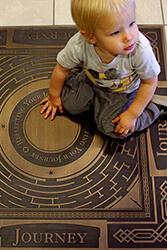What is design for?
Design is problem solving.
Art may follow the muse, but design always has a goal. The work of the graphic designer is to exercise creativity in the service of some purpose. While the artist has the freedom to express and explore—in a sense, to ask questions and create “problems” for the audience—the designer is always working to solve some problem on behalf of the audience.
Design is hospitality.
At a basic level, the designer plays the role of a thoughtful host, welcoming the audience into an unfamiliar space and guiding their attention around the material in a way that makes them feel at home.
Design is gift-giving.
A design project is not complete until it has been put to its intended use. A designer working to create a piece for the audience experiences the same joyful expectation that a gift-giver has in choosing and wrapping a Christmas present— but the gift has not really been given until it is unwrapped and enjoyed.
Design is teaching.
The designer takes the time to thoroughly understand the material he or she is presenting, to sort and order and arrange that material, and to guide the uninitiated audience through it. The writers’ maxim that “easy reading requires hard writing” hold true for us as well—if the designer doesn’t do the work to create a thoughtful design, the audience will have that much more work in trying to decipher the final piece.
Design promotes human flourishing.
Signs that help us navigate the streets, books that are easy to read, menus that help us find our preferred foods—graphic design done well is design that serves people well. In fact, design is only worth doing to the extent that it promotes human flourishing. The street signs, or books, or menus will all eventually be mouldering in the landfill but the humans we have served are eternal.
The graphic design industry is sometimes guilty of a condescending attitude toward clients who say, “just make the logo bigger” or give unhelpful feedback like, “I don’t know what I want, but I’ll know it when I see it.”
While those can be frustrating exchanges, the designer cannot permit himself to adopt a sneering posture toward the client. In the end, the ultimate measure of the value of a designer’s work is how well it serves two sets of people: the client, and their audience.
To read more articles like this visit: Uncategorized








